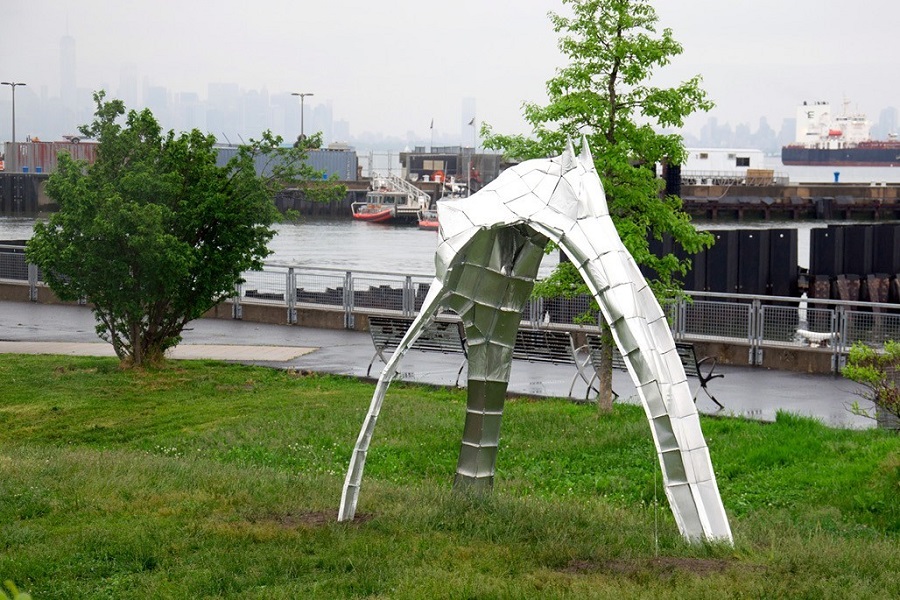News Byte: Re-envisioning Gauds New York City Skyscraper

In 1908, Spanish architect Antoni Gaudí designed a futuristic skyscraper for lower Manhattan. Dubbed the “Hotel Attraction,” the project was to feature a castle-like structure of cone-shaped towers that would have housed a hotel, restaurants, a theatre, an exhibition hall, galleries, and a top-level space offering panoramic views of the city. Soaring more than 1,100 feet, the Hotel Attraction would have been the tallest building in the country at that time.
However, the skyscraper never came to be—unless you count a recent installation led by Pablo Lorenzo-Eiroa, Ph.D., M.Arch II, associate professor of architecture, who also oversees the artificial intelligence lab related to the architectural computational technologies, M.S. program.
On May 18 and 19, as part of the New York City Department of Parks and Recreation’s Art in the Parks exhibition program, visitors to Staten Island’s Stapleton Waterfront Park had the opportunity to visit “Gaudí’s NYC Skyscraper.” Leveraging big data, simulation, artificial intelligence, and robotic fabrication, the installation proposed a different structural prototype based on Gaudí’s explorations, including an optimized construction system with a catenary shell structure. Measuring 8 feet long, 6 feet wide, and 12 feet high, the arch-like structure was made of 100 percent recycled aluminum alloy and enabled park visitors to experience views of the Manhattan, Jersey City, and Brooklyn skylines from inside an “empty skyscraper structural envelope.”
Working under Lorenzo-Eiroa’s supervision and mentorship, several students from the architectural computational technologies program assisted in the project, which was sponsored by a New York Tech Institutional Support for Research and Creativity (ISRC) grant. Students included:
- Mike Saad
- Yashraj Chauhan
- Arefin Chisty
- Selin Dastan
- Jacob Sam
- Meraj Nasir
- Karan Patel
- Alejandro Romero
- Amisha Bavadiya
- Jahan Selim
Latest New York Tech News
- An Alumnus Commitment to the EnvironmentAs an energy management graduate from New York Tech’s Vancouver campus, Jasdeep Gulati (M.S. ’22) is highly invested in educating people about environmental and climate sustainability. Jul 31, 2024
- Vancouver Faculty Win University-Sponsored Research Awards in New ProgramThe new Global Impact Research Grant (GIRG) program has been developed to keep Vancouver-based faculty connected to faculty and research projects being conducted on the university’s New York campuses. Jul 30, 2024
- Studying Climate Change One Degree at a TimeJunhua Qu (M.S. ’24) began her collegiate journey in Beijing. But, her interest in climate change took her to New York Tech’s Vancouver campus to study energy management. Jul 29, 2024
- News Byte: Architecture Program Awarded for DEI EffortsNew York Tech’s Bachelor of Architecture degree program has received Insight Into Diversity magazine’s 2024 Inspiring Programs in STEM Award, recognizing the undergraduate program's encouragement of underrepresented groups to enter STEM fields. Jul 23, 2024
- An Alumnus Takes Down Barriers to Eye CareOptometrist Dean Hart, OD (B.S. ’82), has dedicated his time to service and humanitarianism, donating his resources to provide eye care for those in need locally and around the world. Jul 22, 2024
- Recognizing Our Shared Human FrailtyFor Disability Pride Month, Nicole Calma-Roddin, Ph.D., assistant professor of psychology and counseling, talks about her experience as a disabled person and what that means to her. Jul 17, 2024












